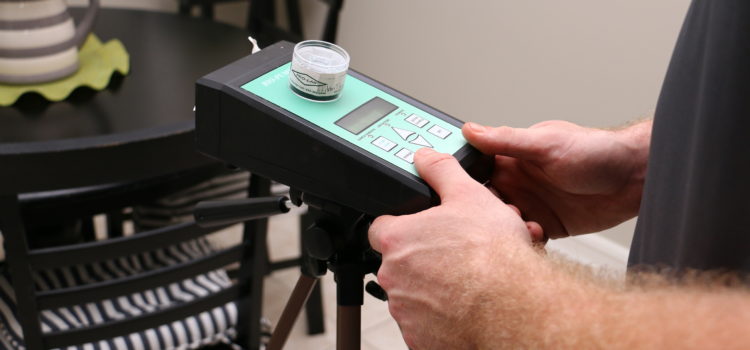Mold testing professionals rely on several sampling methods to precisely identify species and subspecies of fungus as well as other important factors for targeted remediation such as stage in the growth cycle, tendency to spread, and toxigenicity.
Do-it-yourself or home mold tests cannot provide any of this information. It is also impossible to identify fungi based on appearance as there are over 100,000 different types of mold, many of which appear similar or change in color and texture depending on the stage of the growth cycle.
For these reasons, United Water Restoration Group recommends hiring experts who perform mold remediation air quality testing. There are three major advantages to this testing method, which involves obtaining and submitting air samples for lab testing, analysis, and accurate identification.
1. Capturing Off-Gases and Spores
Air samples can be more affordable and useful than bulk or surface samples when it comes to determining the extent of an infestation, stage of mold growth, and concentration of airborne spores. This testing method picks up on the full spectrum of microbial volatile organic compounds and airborne spores present at the time and place where the sample is taken.
Occupants of a structure are more likely to be exposed to these particles, and spores may spread an infestation throughout a structure if conditions are conducive to mold growth in locations other than the primary site of an infestation.
Testing for mold through air quality is also ideal for situations in which more than one type of fungus may be growing or limited access or visibility are factors. Although expert mold testing and analysis can be costly, the detailed results are worth the investment. Home mold tests may seem like a better deal than professional air quality testing, but these kits are notorious for returning false positives and do not provide detailed information about mold species.
Among professional mold testing methods, air quality testing surpasses bulk and surface sampling as the best way to detect whether one or more types of fungus are present based on the fewest samples. Professional testing and lab analysis can cost several hundred dollars, but this expense will likely amount to money saved on imprecise testing and remediation methods.
2. Identifying Active and Old Growth
Mold remediation air quality testing that captures mVOCs for analysis is useful for determining the life-cycle stage of the fungi present in a structure. The fungus only releases off-gases when digesting and metabolizing nutriment. If these chemicals are present in an air sample, it is likely that excessive moisture is currently supporting the proliferation of mold somewhere in a structure. Thermal cameras and other moisture and leak-detection technology may be useful for tracking down the cause of a hidden mold infestation.
The particular gases that are detected through this testing method can shed light on the species and subspecies of mold and be helpful for determining whether a fungus is toxigenic. Some of the most common mVOCs include acetaldehyde, butanoic acid, camphene, camphor, furfural, geosmin, and methanol.
Unlike bulk or surface samples, air quality testing can also indicate whether dried spores from a prior infestation are still capable of spreading. Dry spores can detach from surfaces and become airborne more easily. Even if an infestation is not growing, it may still be capable of spreading spores to parts of a structure where conditions can sustain growth.
3. Implementing Results During Cleanup
A remediation effort is more likely to be successful if cleanup professionals have accurate information about mold species at the start of the process. Air quality testing can provide a more complete picture than isolated bulk or surface samples. Bulk or surface samples may be helpful for isolated colonies or infestations but may not indicate all of the types of old and new fungal growth that are present in a structure.
United Water Restoration Group connects property owners with mold remediation air quality testing services. After air samples have been gathered and submitted to a lab for analysis, it may take days for results to come in. It may be possible to take mitigation measures to limit ongoing water damage during this time. When detailed results are available, this information will be invaluable for identifying the best approach to remediation. It may take days or weeks to remove mold from a structure.
We provide services in Ormond Beach, Florida, Jacksonville, Florida, Daytona Beach, Florida, Orlando, Florida, Tampa, Florida, Melbourne, Florida, and many other locations around Florida!





